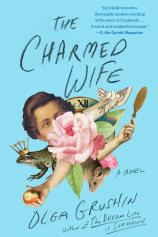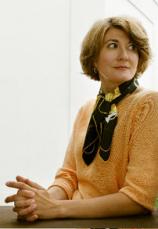The Charmed Wife
Review
The Charmed Wife
From acclaimed novelist Olga Grushin comes THE CHARMED WIFE, a fractured --- if not downright broken-down --- fairy tale about what happens 13 ½ years after Cinderella loses her crystal shoe and finds herself ensconced in a gilded palace.
Following the general gist of the rags-to-riches story told to children through books and Disney films, Grushin introduces readers to a grown-up Cinderella, a woman who has already married the man of her dreams, given birth to his children and lived as a perfect princess, now queen. Despite their fairy tale surroundings --- complete with talking mice, dancing teapots and frogs waiting to be kissed --- Cinderella and King Roland have not felt the “happy” of “happily ever after” in quite some time. And she is ready to close the book on her fairy tale ending.
On the night we meet Cinderella, she is fleeing the castle under the cover of darkness to meet with a witch at a magical crossroads. In exchange for the king’s nail clippings, golden hairs, a portrait and an egg-sized sapphire, the witch has agreed to cast a spell on Cinderella’s husband. No stranger to the flaws of men, she expects Cinderella to request a love potion, or a kindness spell, or even a curse that will prevent him from straying to other women’s beds. But even the witch is shocked when she reveals that she wants her Prince Charming dead.
"Sophisticated, inventive and endlessly witty, THE CHARMED WIFE is a fresh and wildly original take on fairy tales, marriage and one woman’s search for happiness.... [T]his creepy cool novel will inspire a whole new generation of princesses to save themselves."
With a dramatic entrance from Cinderella’s fairy godmother, the spell goes awry, and the witch and the godmother finally ask the queen what has made her so unhappy. Slowly and carefully, Cinderella shares her side of the story and explains what has happened after her “perfect” ending. As she chronicles years of abuse --- both obvious and more insidious --- she comes to see the ways in which she has prevented herself from achieving happiness, and just how blind she has been to the true flaws of her happy ending. Suffice it to say that Prince Roland is not very princely; in fact, he is a womanizing, calculating man with no real accomplishments of his own.
However, even more shocking is how long it took Cinderella to realize that his mysterious trips to nearby kingdoms were not hunts, but dalliances, and that the magic potions her fairy godmother-turned-therapist has been feeding her have not helped her find happiness, but dulled her senses and increased her waistline. Painfully but shrewdly, Cinderella starts to ask, “What if the slipper had fit someone else --- would the prince have married the other girl instead, would he have even known the difference? Was she, in fact, all that different from every other maiden with a sweet singing voice and a patient disposition?”
Interspersed among the queen’s tale are snippets about her evil stepsisters (not so evil, as it turns out), her beloved mice friends (long gone, but replaced every few years so as not to upset Cinderella), and even other fairy tale stars like Sleeping Beauty and Snow White (yet more women failed by the rules of fairy tales). Grushin skillfully unpacks every aspect of fairy tales, such as the unbelievability of insta-love, the bindings of the rules of magic, and even the ways that evil witches may have been trying to help all along. As Grushin makes clear, the same fairy tale laws that make magic possible also bind their characters and limit their worldviews. And, having seen that there is far more to happiness than a glass slipper and a handsome prince, Cinderella can no longer turn a blind eye to the dystopia around her. With the push of a former princess and a not-so-witchy witch, she enters the world of divorces, new careers and making a name for herself on her own terms.
The idea of a fractured fairy tale is instantly compelling in its subversiveness. After all, who among us has not grown tired of stories of princesses, magic spells and dashing princes with little to no personality? But what Grushin does by focusing on an adult Cinderella takes the fractured fairy tale to the next level, not only challenging the stories we have been spoon-fed since we were children, but also drawing painfully relatable real-life parallels on topics like weight and beauty, aging and, of course, the dissolution of a once-happy relationship.
Even in passages written about Cinderella’s evening-wear-making mice, Grushin pushes the envelope on the potential of the fairy tale and asks, “But what would really happen if country mice were suddenly in possession of fancy cheese, gold-foiled whiskers and cardboard manors?” Affairs, bloodshed, coups and cults, as it turns out. Though the toils of the fantasy world can occasionally be hard to follow, Grushin makes a valiant effort to include nods to other fairy tales, push the limits of the demanding, exacting magic system, and throw in a bit of whimsy as she goes.
Sophisticated, inventive and endlessly witty, THE CHARMED WIFE is a fresh and wildly original take on fairy tales, marriage and one woman’s search for happiness. Perfect for readers of WICKED, CONFESSIONS OF AN UGLY STEPSISTER and THE BEAST’S HEART, this creepy cool novel will inspire a whole new generation of princesses to save themselves.
Reviewed by Rebecca Munro on January 29, 2021
The Charmed Wife
- Publication Date: January 11, 2022
- Genres: Fiction, Magical Realism
- Paperback: 288 pages
- Publisher: G.P. Putnam's Sons
- ISBN-10: 0593085523
- ISBN-13: 9780593085523




